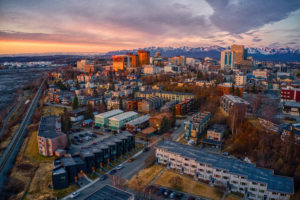
Not if the April 2022’s most recent building safety activity report is any indication. Single family building permits are up from 62 to 73 but duplex permits are down from 24 units in 2021 to 8 this year. That’s a breakeven number for the two most desirable housing types. The good news is that there were ten multi-family applications for 137 units which was an increase of 85 units. The bulk of those permits is the market rate Debenham apartment complex next to the old Anchorage hospital building in the hopes of adding rental population to the downtown core.
But the real dilemma for more housing is more complex than finger counting permits. Anchorage has had approximately a 40% decline in the amount of buildable residential land since l998. The good land is gone. And by good I mean residential land that is accessible by road; with water and sewer adjacent to the site; without bedrock or wetlands and with only a gently rolling topography. Last year’s cost for the extension of roads, water, and sewer within a tract was $1,200 or $95,000 which did not include gas and electric for a fifty foot wide lot. I’m sure that cost has now gone up at least 15%, along with an increase in commercial rates of interest for borrowing. A raw land acquisition financed by a lender requires a 25% down payment and a rate of interest at least 2-3% higher than a home mortgage. Today, most residential land developers are also vertical home builders like Hultquist Homes, Spinell and Michael Quinn in Eagle River. They buy land, develop it and exclusively build the homes. That’s no different than how the publicly traded builders in Arizona do business who collectively purchased over $8 billion in raw land in the last year. So buyers who want a new home built are faced with the difficult reality of being forced to do business with the land owner/builder. Alternatively, the occasional infill lot the purchased by a neighbor to protect a view or privacy is hard to find and then the new build home is frequently compared to the down the street which may be twenty years old.
A National Association of Home Builders study reported that 23.8% of the cost of development was in regulatory oversite. That’s a percentage that the Anchorage Assembly and the current Bronson administration can and could work together to reduce. The need for more housing is something we can all agree on even if it’s as simple to allow a four plex building to be classified as residential rather than the commercial application requirement. Anchorage is going to become a city of higher density but the choice is how high in elevation and the size and number of units. The two large demographic bulges in our population are definitely at odds with one another. The ‘aging’ boomer wanting and needing to downsize away their maintenance and increasing rising utility bills and the ‘aging’ millennial who wants a suburban lifestyle like where they were raised close to good schools and shopping.
But the big stall in residential development may still be in the not in my backyard attitude of neighbors. Residential land development is a three legged stool. A successful development requires the support of the planning department, the surrounding community and the ability of the developer to obtain financing and make a reasonable profit. The longer the delays for approval the higher cost of the new home.
Thank You for your many referrals. Please feel free to contact me with any real estate questions.

 Connie Yoshimura is the Owner and Broker of Berkshire Hathaway HomeServices Alaska Realty. With over 40 years of residential real estate experience, she continues to be a leader in Alaska’s housing market. Most recently, she sold the highest-priced home ever recorded in the Alaska MLS.
Connie Yoshimura is the Owner and Broker of Berkshire Hathaway HomeServices Alaska Realty. With over 40 years of residential real estate experience, she continues to be a leader in Alaska’s housing market. Most recently, she sold the highest-priced home ever recorded in the Alaska MLS.
Leave a Reply